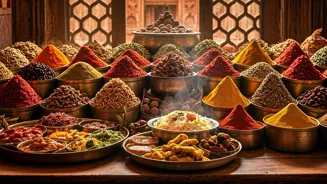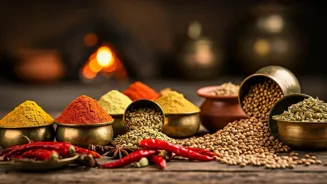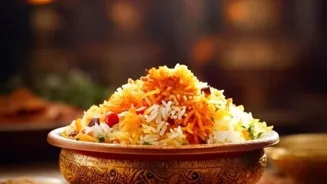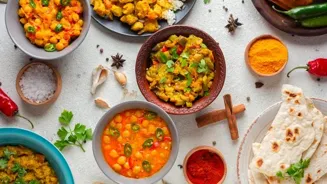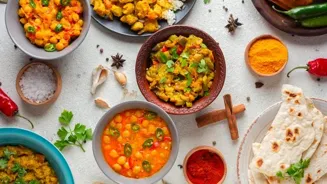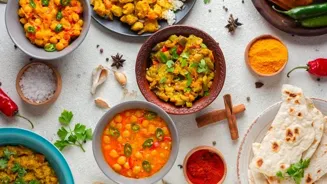Unraveling the Heritage of Biryani: A Culinary Journey from Royalty to Every Home. Explore the captivating evolution of this iconic dish
Biryani, a dish that evokes a sense of celebration and comfort, holds
a special place in the hearts (and stomachs!) of Indians. But beyond its delightful taste, lies a rich history, a journey from the grand kitchens of emperors to the humble tables of our homes.

It's more than just food, it's a culinary legacy, deeply intertwined with culture, tradition, and the stories of empires past.
This article delves into the captivating history of biryani, tracing its origins, evolution, and eventual arrival as a beloved staple in Indian cuisine, enjoyed by everyone, regardless of background. Get ready to discover the fascinating story behind your favorite plate of fragrant rice!
The origin of biryani is debated, with ties to Persia and India's rich culinary history
The precise origin of biryani is debated, with multiple theories adding to its mystique. One popular belief traces it back to Persia. It is said that the dish arrived in India with the Mughals, who were known for their love of elaborate and flavorful cuisines.
Soldiers arriving brought their special dishes and added to the cuisine. Another theory suggests that biryani was already present in India, in various forms, before the Mughal era. These earlier versions may have been simple rice dishes seasoned with spices, gradually evolving over time.
Regardless of its exact origin, biryani's association with royalty is undeniable. It was, after all, a dish fit for kings, prepared with the finest ingredients and techniques. The blending of various culinary styles is what makes the dish different.
Mughal emperors influence biryani evolution in India's regions
The Mughal emperors, known for their refined taste, played a vital role in popularizing and refining biryani. The royal kitchens, under the supervision of skilled chefs, became laboratories where culinary experiments flourished.
Ingredients like saffron, aromatic spices, and dried fruits were added to the rice, elevating the dish to a new level of luxury. Different regions of India, under Mughal influence, developed their own unique styles of biryani.
Lucknow, Hyderabad, and Delhi became renowned for their distinct versions, each reflecting local flavors and preferences. The Awadhi biryani of Lucknow, for instance, is characterized by its slow cooking method and subtle aroma.
The Hyderabadi biryani, is known for its bold spices and flavor palette. Thus, slowly the dish adapted and created different varieties.
Biryani's journey from elite dish to common staple in India
As the Mughal empire declined, biryani's influence spread beyond the royal courts. Cooks and chefs, previously employed in the royal kitchens, ventured out to establish their own businesses. This helped to popularize the dish amongst the general population.
Gradually, biryani became more accessible, moving from a dish reserved for the elite to a celebratory staple enjoyed by the common man. Local ingredients and regional variations continued to emerge, making biryani an integral part of India's diverse culinary landscape.
What was once special became the norm with time. The variations helped people experiment with their food palate further.
Biryani: a versatile Indian dish with endless regional variations
Today, biryani is a ubiquitous dish found across India. From street vendors to high-end restaurants, everyone offers their unique rendition of this culinary masterpiece.. Every region boasts its own distinct style, reflecting local flavors and preferences.
Whether it's the Kolkata biryani with its subtle sweetness or the Thalassery biryani of Kerala with its unique blend of spices, the variations are endless. The modern biryani has also adapted to changing lifestyles.
Ready-to-cook biryani mixes and instant versions are now available, making it easier than ever to enjoy this iconic dish at home. The beauty lies in the freedom to change it as you please, as per your own taste palates.
This is what makes the dish different, and always adaptable to change and user preference.
Biryani's cultural journey and enduring popularity unite people worldwide
Biryani's journey, from royal kitchens to home tables, is a story of cultural exchange, culinary innovation, and enduring popularity. It is a dish that transcends social barriers, bringing people together to savor its rich flavors and fragrant aroma.
More than just a meal, biryani serves as a reminder of India's glorious past, its diverse culinary heritage, and its ability to adapt and innovate. As we enjoy our next plate of biryani, let us take a moment to appreciate the history and tradition woven into every grain of rice.
From small vendors, to big shops, the dish is now available everywhere. The taste is something which is celebrated by everyone and is enjoyed with great appreciation. The making of biryani is also not a simple task, and requires a lot of time, patience and practice.
Thus, with time it is expected that the dish will be innovated even further.
AI Generated Content. Glance/InMobi shall have no liability for the content
